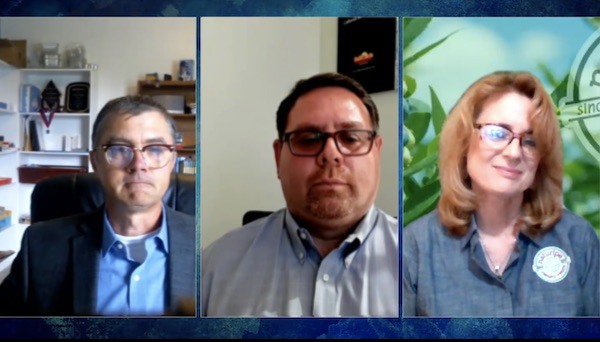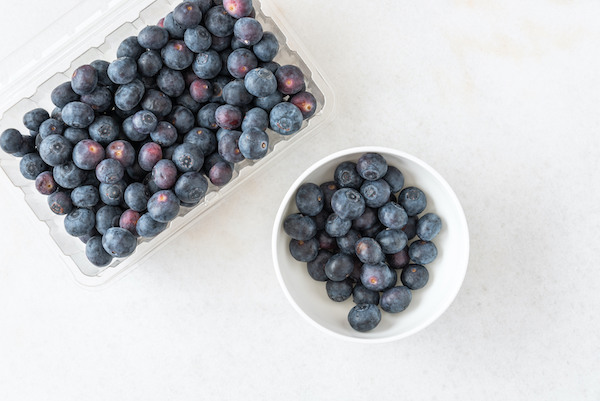On the first day of the NABC/USHBC Virtual Conference and Expo, John Keeley of Highland Packaging, Rick Tomlinson of the California Strawberry Commission and Janis McIntosh of Naturipe Farms discussed the history and future of recycling in the produce industry. One of the main focuses of this session was how to make produce clamshells more recyclable. John Keeley of Highland Packaging explains: “While the produce clamshell is known for using recycled material and diverting plastic bottles from a landfill to the more noble purpose of bringing fresh produce to consumers, the produce clamshell itself is now often ending up in landfills itself at the end of its life. That is why we’ll be focusing on how to give the produce clamshell a second life by making it recycle ready.”

From left to right: John Keeley, Rick Tomlinson, and Janis McIntosh.
Increasing recyclability of clamshells
One of the first questions that was addressed by the panel was that of why the focus is on making clamshells more recycle-ready, rather than pivoting to other packaging options that are already recycle-ready. Keeley says: “It isn’t economically sustainable to make the large capital investment into switching out the current clamshell packaging into other types of packaging. While the top seal package is already recycle-ready, for example, the investment it would take to switch over to this type of packaging isn’t something we can expect of all growers in the industry.”
In addition to this, there’s the fact that consumers want to be able to see their produce, which is something that isn’t always possible with other packaging materials, such as paper. Janis McIntosh of Naturipe Farms also shares: “Alternative bioplastic options, like sugarcane for example, were an option and were growing in popularity prior to covid-19. Now, the demand for plastic is back and we are seeing that it is one of the safest things we have in the produce department. In addition to this, there are just not enough raw materials to replace the entirety of the PET plastics that make up the clamshells today. PET plastic is here to stay for a number of reasons, besides safety issues.”

Challenges with recycling clamshells
So, what are the reasons that the clamshells aren’t currently being recycled? “For one, there’s no bill that incentivizes the recycling of clamshells, as there was for the plastic bottle industry,” Keeley says. “The produce clamshells are also difficult to sort from other types of clamshells,” he adds. Rick Tomlinson of the California Strawberry Commission explains further: “Since PET is the most recycled plastic in the world, the good news is that most recycling facilities are set up to recycle this material. The issues, however, lie in the differences between the PET bottles and the PET clamshells. The shape is different, and the label is different – PET bottles using a plastic label, while clamshells mostly use paper labels. This is what is causing roadblocks to recycling the clamshells for many facilities.”
How to give the clamshells a second life
The label issue is one of the major challenges that is causing clamshells to end up in landfills. “The adhesive used by the paper labels is what is causing the issues, and many facilities aren’t set up do these with this,” Keeley says. “When the clamshells use a polypropylene label with the right stock and adhesive, approved by the Association of Plastic Recyclers, it ensures that the label separates easily from the PET in the recycling process. This then allows the creation of clean-wash thermoform flakes which can be re-incorporated into the new clamshells. Extruders and thermoformers have agreed to incorporate these clean-wash thermoform flakes into the clamshells at a target rate of 10%, and with the major marketers now requiring this, there is an incentive and economic reason for doing so,” he explains.

McIntosh adds: “The whole idea of 10% thermoform is critical. It’s the circular economy that is missing – there’s no reason we shouldn’t be using our own content to create new clamshells. At Naturipe, we’ve been going through the process of converting our labels for the past 18 months and this year we are working on vetting our suppliers to ensure that there will be no issues when it’s rolled out. In addition to switching to the polypropylene labels, we’re also committed to telling the story on the label. It’s imperative that we have the messaging on the outside of the label, to let consumers know that the clamshells are recyclable, but, in addition to this, to also explain how to recycle the clamshell, which is what we do on the inside of our label.”
“With more and more global companies committing to using recycled plastic, as well as the PET bottle industry committing to incorporating more recycled materials into the bottles, there is going to be increased competition for recycled material,” Tomlinson adds. “So, let’s make sure the clamshells are as recycle-ready as possible. We have seen a really strong commitment from the berry industry on this, both in and outside of the US.”
McIntosh concludes: “I feel very good and confident about everything we have been doing as an industry. The fact that we’re all working together is great. This is not a competitive thing, it’s something we just have to do.”
To register to attend the final days of the NABC/USHBC Virtual Conference and Expo, click here.
